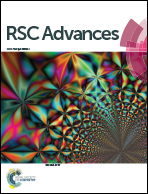BiPO4/Bi2S3-HKUST-1-MOF as a novel blue light-driven photocatalyst for simultaneous degradation of toluidine blue and auramine-O dyes in a new rotating packed bed reactor: optimization and comparison to a conventional reactor
Abstract
BiPO4/Bi2S3-HKUST-1-MOF as a novel blue light active photocatalyst was synthesized and characterized by X-ray XRD, SEM, PL, BET, BJH and DRS. This novel photocatalyst was applied in a new catalytic rotating packed bed reactor for intensification of simultaneous photocatalytic degradation of toluidine blue (TB) and auramine-O (AO). In this reactor, high gravity media generated by a high rotational speed in a porous domain leads to intensification of the external mass transfer rate and significantly increases the mixing and turbulency. The central composite design (CCD) following analysis of variance (ANOVA) was applied to optimize the operational parameters including irradiation time, pH, photocatalyst dosage, rotational speed, solution flow rate, aeration flow rate, and TB and AO concentration. The optimum values were found to be 65 min, 6, 0.25 g L−1, 1300 rpm, 0.40 L min−1, 35 L min−1, 25 and 25 mg L−1 for irradiation time, pH, photocatalyst dosage, rotational speed, solution flow rate, aeration rate and initial concentration of TB and AO, respectively. At these optimum conditions, the photocatalytic degradation percentages of TB and AO were found to be 99.37% and 98.44% respectively with an overall desirability of 1.0. Replication of all experiments at optimum conditions with a conventional photocatalytic reactor shows the requirement of more photocatalyst as well as more irradiation time for operation in comparison to the rotating packed bed reactor. Results showed that the rotating packed bed is more economical, has a higher efficiency and can operate at a higher flow rate. Kinetic studies are an essential step in designing and optimizing photocatalytic reactors during scale-up processes, a pseudo first order kinetics based on the Langmuir–Hinshelwood (L–H) model was able to successfully fit the data concerning the present photodegradation approach.


 Please wait while we load your content...
Please wait while we load your content...